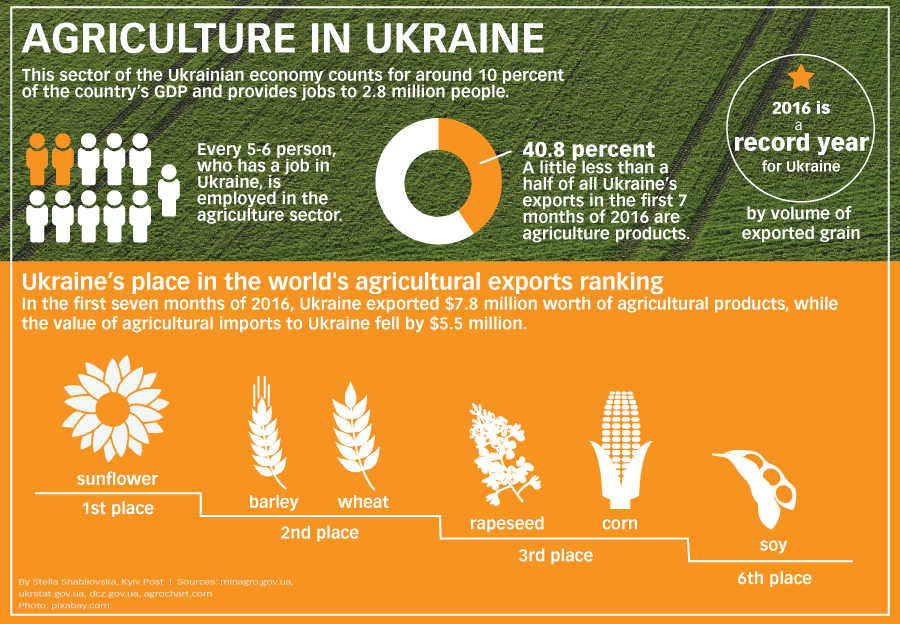Ukraine is a big player on the global agricultural market, especially in exports of crops and meat. The sector accounts for 10 percent of gross domestic product and employs 15 percent of the working-age population.
But with smaller farmers forced to lease land without the possibility to buy it and, at the same time, using aging, inefficient machinery because they can’t afford newer equipment, Ukraine can’t do much better.
Against this backdrop, the ratification of an agreement with European Investment Bank – an €400 million investment program designed specifically to boost Ukraine’s agricultural business – seems to be the right step towards rescuing the most promising sectors of the country’s economy.
Ex-Prime Minister Arseniy Yatsenyuk signed the covenant with the European Investment Bank on Dec. 28, 2015. Verkhovna Rada deputies ratified it on Sept. 20, almost one year later.
This, along with an increase in the total volume of capital investments of up to $6.5 million over the first six months of 2016 – 74 percent more than during the same period in 2015 – shows that the investment hole is being partially plugged.
At the same time, the farmers’ inability to dispose of their own land still limits the Ukrainian agriculture sector.

EIB investments
Investment in agriculture has always been crucial for the economic development and food security of Ukraine. But since many farmers are already in debt to banks or suppliers of fertilizer and plant-protection chemicals, and since agricultural loans are not guaranteed by the government, few banks are willing to grant long-term credits.
Thus, Ukraine has no choice but to rely on European investment programs.
And one of them is a loan program by the nonprofit European Investment Bank (EIB), the world’s largest public lending institution, established back in 1958 under the Treaty of Rome. It’s owned by the EU member states.
“The EIB credit mediated by Ukrainian banks will simplify farmers’ access to necessary funding on beneficial terms,” Natalia Shpigotska, an analyst at Dragon Capital, told the Kyiv Post.
Ukraine’s Finance Ministry will obtain the credit and give the money to private banks through state-owned Ukreximbank. Chosen private banks, for their part, will pick out agriculture projects seeking funding, monitor their work and assess further results.
The credit terms were set at up to 12 years, with a four-year grace period from 2016 to 2020. The maximum amount of money one project can get is €50 million, but each loan can cover no more than 50 percent of farmers’ projected costs.
“Ukrainian banks rarely give credits under such conditions,” Shpigotska said.
Such loans will allow smaller farmers, who work 12 percent of Ukraine’s agricultural land, to invest into their oil and grain processing projects, along with infrastructure ones that have long payback terms.
Ukraine’s Agriculture Minister Taras Kutoviy believes the EIB program will help farms to develop in the country.
It will help “small and medium farmers to find their niche, become competitive and be capable of contributing to developing agriculture in the whole country,” Kutoviy said on Sept. 20, right after the agreement was ratified.
Straining factors
Farmers’ difficulty in obtaining anything other than short-term, high-interest loans, as well as the moratorium on selling plots, places severe constraints on their ability to invest in long-term capital improvements. Modern agricultural machinery can help boost production, and greater storage capacity could potentially give farmers more bargaining power on prices.
Ukrainian farm managers estimate that 10-20 percent of the standing crop is typically lost due to outdated, inefficient equipment.
Meanwhile, the moratorium on land sales is likely to be kept in place indefinitely by Ukraine’s lawmakers. Ukraine’s Prime Minister Volodymyr Groysman said the moratorium on land selling would last at least until 2017.
“It’s a very discussable issue that needs to be resolved,” Groysman said at the YES conference on Sept. 17. “We need to approach it in such a way so not to make any mistakes.”
The only option now is to lease land, but Dmytro Ognev, a Ukrainian cattle farmer, is skeptical about it, saying it’s almost impossible to rent a plot on terms beneficial for small farmers. “Agro holdings always win tenders,” Ognev told the Kyiv Post. “There’s no land market.”
Favorable conditions
Although conditions for country’s agriculture are not ideal in many ways, the fertility and amount of arable land – 42 million hectares, or 70 percent all Ukraine’s total area – keeps Ukraine among the world leaders.
Ukraine’s fertility allows it to export at least 30 percent of the crops it produces, according to a fact book on Ukraine’s agriculture compiled by the Business Views (2015).
For example, one of Ukraine’s national symbols, the sunflower, is used to produce both cooking oil and sunflower seeds, and brings in $3 billion in export revenues. The same amount of money is brought in by corn production. And Ukraine makes more than $3 billion from grain and nuts exports.
Meat, soy, dairy, leather and fur, alcohol, honey and nuts bring in less money, but still make up a significant portion of the country’s GDP.
